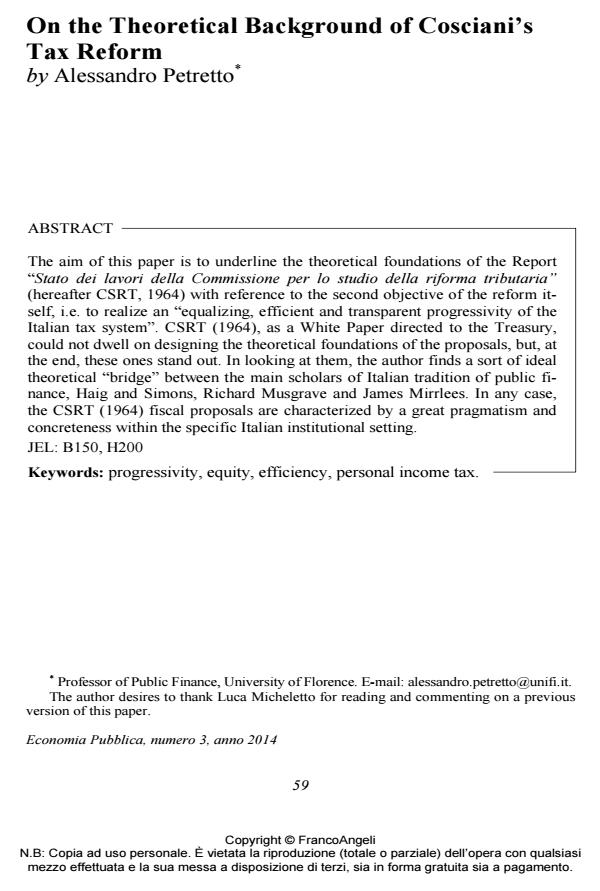On the Theoretical Background of Cosciani’s Tax Reform
Titolo Rivista ECONOMIA PUBBLICA
Autori/Curatori Alessandro Petretto
Anno di pubblicazione 2015 Fascicolo 2014/3
Lingua Inglese Numero pagine 21 P. 59-79 Dimensione file 187 KB
DOI 10.3280/EP2014-003004
Il DOI è il codice a barre della proprietà intellettuale: per saperne di più
clicca qui
Qui sotto puoi vedere in anteprima la prima pagina di questo articolo.
Se questo articolo ti interessa, lo puoi acquistare (e scaricare in formato pdf) seguendo le facili indicazioni per acquistare il download credit. Acquista Download Credits per scaricare questo Articolo in formato PDF

FrancoAngeli è membro della Publishers International Linking Association, Inc (PILA)associazione indipendente e non profit per facilitare (attraverso i servizi tecnologici implementati da CrossRef.org) l’accesso degli studiosi ai contenuti digitali nelle pubblicazioni professionali e scientifiche
The aim of this paper is to underline the theoretical foundations of the Report "Stato dei lavori della Commissione per lo studio della riforma tributaria" (hereafter CSRT, 1964) with reference to the second objective of the reform itself, i.e. to realize an "equalizing, efficient and transparent progressivity of the Italian tax system". CSRT (1964), as a White Paper directed to the Treasury, could not dwell on designing the theoretical foundations of the proposals, but, at the end, these ones stand out. In looking at them, the author finds a sort of ideal theoretical "bridge" between the main scholars of Italian tradition of public finance, Haig and Simons, Richard Musgrave and James Mirrlees. In any case, the CSRT (1964) fiscal proposals are characterized by a great pragmatism and concreteness within the specific Italian institutional setting.
ABSTRACT Scopo del lavoro è delineare i presupposti teorici del Rapporto curato dalla Commissione per lo Studio della Riforma Tributaria (CSRT, 1964), con riferimento al secondo degli obiettivi posti alla base della riforma stessa, ovvero la realizzazione di "una progressività perequata, efficiente e trasparente del sistema tributario italiano". CSRT (1964), per sua natura di rapporto tecnico al ministro, non poteva tracciare compiutamente le basi teoriche sedimentate, che, tuttavia, alla fine vengono fuori. Nel delineare queste, l’autore propone di gettare una sorta di "ponte" teorico ideale tra i contributi seminali di Haig-Simons, Musgrave e Mirrlees, sulla base dei legami che si possono intravedere nel Rapporto. Nelle proposte risulta evidente anche l’influenza della Tradizione Italiana di Scienza delle Finanze che ha ispirato la formazione culturale degli economisti della Commissione Cosciani.
Parole chiave:Progressività; equità; efficienza; imposta personale sul reddito
Jel codes:B150, H200
Alessandro Petretto, On the Theoretical Background of Cosciani’s Tax Reform in "ECONOMIA PUBBLICA " 3/2014, pp 59-79, DOI: 10.3280/EP2014-003004